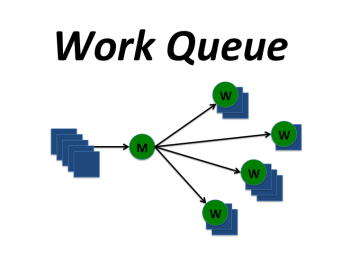Configuration¶
Parsl separates program logic from execution configuration, enabling
programs to be developed entirely independently from their execution
environment. Configuration is described by a Python object (Config)
so that developers can
introspect permissible options, validate settings, and retrieve/edit
configurations dynamically during execution. A configuration object specifies
details of the provider, executors, connection channel, allocation size,
queues, durations, and data management options.
The following example shows a basic configuration object (Config) for the Frontera
supercomputer at TACC.
This config uses the HighThroughputExecutor to submit
tasks from a login node (LocalChannel). It requests an allocation of
128 nodes, deploying 1 worker for each of the 56 cores per node, from the normal partition.
The config uses the address_by_hostname() helper function to determine
the login node’s IP address.
from parsl.config import Config
from parsl.channels import LocalChannel
from parsl.providers import SlurmProvider
from parsl.executors import HighThroughputExecutor
from parsl.launchers import SrunLauncher
from parsl.addresses import address_by_hostname
config = Config(
executors=[
HighThroughputExecutor(
label="frontera_htex",
address=address_by_hostname(),
max_workers=56,
provider=SlurmProvider(
channel=LocalChannel(),
nodes_per_block=128,
init_blocks=1,
partition='normal',
launcher=SrunLauncher(),
),
)
],
)
Configuration How-To and Examples:
Note
All configuration examples below must be customized for the user’s allocation, Python environment, file system, etc.
How to Configure¶
The configuration specifies what, and how, resources are to be used for executing the Parsl program and its apps. It is important to carefully consider the needs of the Parsl program and its apps, and the characteristics of the compute resources, to determine an ideal configuration. Aspects to consider include: 1) where the Parsl apps will execute; 2) how many nodes will be used to execute the apps, and how long the apps will run; 3) should Parsl request multiple nodes in an individual scheduler job; and 4) where will the main Parsl program run and how will it communicate with the apps.
Stepping through the following question should help formulate a suitable configuration object.
Where should apps be executed?
Target |
Executor |
Provider |
|---|---|---|
Laptop/Workstation |
||
Amazon Web Services |
||
Google Cloud |
||
Slurm based system |
||
Torque/PBS based system |
||
Cobalt based system |
||
GridEngine based system |
||
Condor based cluster or grid |
||
Kubernetes cluster |
- beta
WorkQueueExecutor is available in
v1.0.0in beta status.
How many nodes will be used to execute the apps? What task durations are necessary to achieve good performance?
Executor |
Number of Nodes * |
Task duration for good performance |
|---|---|---|
1 (Only local) |
Any |
|
<=2000 |
Task duration(s)/#nodes >= 0.01 longer tasks needed at higher scale |
|
>1000, <=8000 † |
>minutes |
|
<=1000 ‡ |
10s+ |
- *
Assuming 32 workers per node. If there are fewer workers launched per node, a larger number of nodes could be supported.
- †
8,000 nodes with 32 workers (256,000 workers) is the maximum scale at which the
ExtremeScaleExecutorhas been tested.- ‡
The maximum number of nodes tested for the
WorkQueueExecutoris 10,000 GPU cores and 20,000 CPU cores.
Warning
IPyParallelExecutor is deprecated as of Parsl v0.8.0. HighThroughputExecutor
is the recommended replacement.
3. Should Parsl request multiple nodes in an individual scheduler job? (Here the term block is equivalent to a single scheduler job.)
|
||
|---|---|---|
Provider |
Executor choice |
Suitable Launchers |
Systems that don’t use Aprun |
Any |
|
Aprun based systems |
Any |
|
|
||
|---|---|---|
Provider |
Executor choice |
Suitable Launchers |
Any |
||
Any |
||
Any |
|
|
Note
If using a Cray system, you most likely need to use the AprunLauncher to launch workers unless you
are on a native Slurm system like Cori (NERSC)
Where will the main Parsl program run and how will it communicate with the apps?
Parsl program location |
App execution target |
Suitable channel |
|---|---|---|
Laptop/Workstation |
Laptop/Workstation |
|
Laptop/Workstation |
Cloud Resources |
No channel is needed |
Laptop/Workstation |
Clusters with no 2FA |
|
Laptop/Workstation |
Clusters with 2FA |
|
Login node |
Cluster/Supercomputer |
Heterogeneous Resources¶
In some cases, it can be difficult to specify the resource requirements for running a workflow. For example, if the compute nodes a site provides are not uniform, there is no “correct” resource configuration; the amount of parallelism depends on which node (large or small) each job runs on. In addition, the software and filesystem setup can vary from node to node. A Condor cluster may not provide shared filesystem access at all, and may include nodes with a variety of Python versions and available libraries.
The WorkQueueExecutor provides several features to work with heterogeneous resources.
By default, Parsl only runs one app at a time on each worker node.
However, it is possible to specify the requirements for a particular app,
and Work Queue will automatically run as many parallel instances as possible on each node.
Work Queue automatically detects the amount of cores, memory, and other resources available on each execution node.
To activate this feature, add resource specifications to your apps:
@python_app def compute(x, parsl_resource_specification={'cores': 1, 'memory': '1GiB', 'disk': '1GiB'}): return x*2
This special keyword argument will inform Work Queue about the resources this app requires.
When placing instances of compute(x), Work Queue will run as many parallel instances as possible based on each worker node’s available resources.
If an app’s resource requirements are not known in advance,
Work Queue has an auto-labeling feature that measures the actual resource usage of your apps and automatically chooses resource labels for you.
With auto-labeling, it is not necessary to provide parsl_resource_specification;
Work Queue collects stats in the background and updates resource labels as your workflow runs.
To activate this feature, add the following flags to your executor config:
config = Config( executors=[ WorkQueueExecutor( # ...other options go here autolabel=True, autocategory=True ) ] )
The autolabel flag tells Work Queue to automatically generate resource labels.
By default, these labels are shared across all apps in your workflow.
The autocategory flag puts each app into a different category,
so that Work Queue will choose separate resource requirements for each app.
This is important if e.g. some of your apps use a single core and some apps require multiple cores.
Unless you know that all apps have uniform resource requirements,
you should turn on autocategory when using autolabel.
The Work Queue executor can also help deal with sites that have non-uniform software environments across nodes. Parsl assumes that the Parsl program and the compute nodes all use the same Python version. In addition, any packages your apps import must be available on compute nodes. If no shared filesystem is available or if node configuration varies, this can lead to difficult-to-trace execution problems.
If your Parsl program is running in a Conda environment,
the Work Queue executor can automatically scan the imports in your apps,
create a self-contained software package,
transfer the software package to worker nodes,
and run your code inside the packaged and uniform environment.
First, make sure that the Conda environment is active and you have the required packages installed (via either pip or conda):
pythonparslndcctoolsconda-pack
Then add the following to your config:
config = Config( executors=[ WorkQueueExecutor( # ...other options go here pack=True ) ] )
Note
There will be a noticeable delay the first time Work Queue sees an app; it is creating and packaging a complete Python environment. This packaged environment is cached, so subsequent app invocations should be much faster.
Using this approach, it is possible to run Parsl applications on nodes that don’t have Python available at all. The packaged environment includes a Python interpreter, and Work Queue does not require Python to run.
Note
The automatic packaging feature only supports packages installed via pip or conda.
Importing from other locations (e.g. via $PYTHONPATH) or importing other modules in the same directory is not supported.
Ad-Hoc Clusters¶
Any collection of compute nodes without a scheduler can be considered an ad-hoc cluster. Often these machines have a shared file system such as NFS or Lustre. In order to use these resources with Parsl, they need to set-up for password-less SSH access.
To use these ssh-accessible collection of nodes as an ad-hoc cluster, we create an executor
for each node, using the LocalProvider with SSHChannel to identify the node by hostname. An example
configuration follows.
from parsl.providers import AdHocProvider
from parsl.channels import SSHChannel
from parsl.executors import HighThroughputExecutor
from parsl.addresses import address_by_query
from parsl.config import Config
user_opts = {'adhoc':
{'username': 'YOUR_USERNAME',
'script_dir': 'YOUR_SCRIPT_DIR',
'remote_hostnames': ['REMOTE_HOST_URL_1', 'REMOTE_HOST_URL_2']
}
}
config = Config(
executors=[
HighThroughputExecutor(
label='remote_htex',
max_workers=2,
address=address_by_query(),
worker_logdir_root=user_opts['adhoc']['script_dir'],
provider=AdHocProvider(
# Command to be run before starting a worker, such as:
# 'module load Anaconda; source activate parsl_env'.
worker_init='',
channels=[SSHChannel(hostname=m,
username=user_opts['adhoc']['username'],
script_dir=user_opts['adhoc']['script_dir'],
) for m in user_opts['adhoc']['remote_hostnames']]
)
)
],
# AdHoc Clusters should not be setup with scaling strategy.
strategy=None,
)
Note
Multiple blocks should not be assigned to each node when using the HighThroughputExecutor
Note
Load-balancing will not work properly with this approach. In future work, a dedicated provider that supports load-balancing will be implemented. You can follow progress on this work here.
Amazon Web Services¶

Note
Please note that boto3 library must be installed to use AWS with Parsl.
This can be installed via python3 -m pip install parsl[aws]
Amazon Web Services is a commercial cloud service which allows users to rent a range of computers and other computing services.
The following snippet shows how Parsl can be configured to provision nodes from the Elastic Compute Cloud (EC2) service.
The first time this configuration is used, Parsl will configure a Virtual Private Cloud and other networking and security infrastructure that will be
re-used in subsequent executions. The configuration uses the AWSProvider to connect to AWS.
from parsl.config import Config
from parsl.providers import AWSProvider
from parsl.executors import HighThroughputExecutor
from parsl.addresses import address_by_query
config = Config(
executors=[
HighThroughputExecutor(
label='ec2_single_node',
address=address_by_query(),
provider=AWSProvider(
# Specify your EC2 AMI id
'YOUR_AMI_ID',
# Specify the AWS region to provision from
# eg. us-east-1
region='YOUR_AWS_REGION',
# Specify the name of the key to allow ssh access to nodes
key_name='YOUR_KEY_NAME',
profile="default",
state_file='awsproviderstate.json',
nodes_per_block=1,
init_blocks=1,
max_blocks=1,
min_blocks=0,
walltime='01:00:00',
),
)
],
)
ASPIRE 1 (NSCC)¶

The following snippet shows an example configuration for accessing NSCC’s ASPIRE 1 supercomputer. This example uses the HighThroughputExecutor executor and connects to ASPIRE1’s PBSPro scheduler. It also shows how scheduler_options parameter could be used for scheduling array jobs in PBSPro.
from parsl.providers import PBSProProvider
from parsl.launchers import MpiRunLauncher
from parsl.config import Config
from parsl.executors import HighThroughputExecutor
from parsl.addresses import address_by_interface
from parsl.monitoring.monitoring import MonitoringHub
config = Config(
executors=[
HighThroughputExecutor(
label="htex",
heartbeat_period=15,
heartbeat_threshold=120,
worker_debug=True,
max_workers=4,
address=address_by_interface('ib0'),
provider=PBSProProvider(
launcher=MpiRunLauncher(),
# PBS directives (header lines): for array jobs pass '-J' option
scheduler_options='#PBS -J 1-10',
# Command to be run before starting a worker, such as:
# 'module load Anaconda; source activate parsl_env'.
worker_init='',
# number of compute nodes allocated for each block
nodes_per_block=3,
min_blocks=3,
max_blocks=5,
cpus_per_node=24,
# medium queue has a max walltime of 24 hrs
walltime='24:00:00'
),
),
],
monitoring=MonitoringHub(
hub_address=address_by_interface('ib0'),
hub_port=55055,
resource_monitoring_interval=10,
),
strategy='simple',
retries=3,
app_cache=True,
checkpoint_mode='task_exit'
)
Blue Waters (NCSA)¶

The following snippet shows an example configuration for executing remotely on Blue Waters, a flagship machine at the National Center for Supercomputing Applications.
The configuration assumes the user is running on a login node and uses the TorqueProvider to interface
with the scheduler, and uses the AprunLauncher to launch workers.
from parsl.config import Config
from parsl.executors import HighThroughputExecutor
from parsl.addresses import address_by_hostname
from parsl.launchers import AprunLauncher
from parsl.providers import TorqueProvider
config = Config(
executors=[
HighThroughputExecutor(
label="bw_htex",
cores_per_worker=1,
worker_debug=False,
address=address_by_hostname(),
provider=TorqueProvider(
queue='normal',
launcher=AprunLauncher(overrides="-b -- bwpy-environ --"),
scheduler_options='', # string to prepend to #SBATCH blocks in the submit script to the scheduler
worker_init='', # command to run before starting a worker, such as 'source activate env'
init_blocks=1,
max_blocks=1,
min_blocks=1,
nodes_per_block=2,
walltime='00:10:00'
),
)
],
)
CC-IN2P3¶

The snippet below shows an example configuration for executing from a login node on IN2P3’s Computing Centre.
The configuration uses the LocalProvider to run on a login node primarily to avoid GSISSH, which Parsl does not support yet.
This system uses Grid Engine which Parsl interfaces with using the GridEngineProvider.
from parsl.config import Config
from parsl.channels import LocalChannel
from parsl.providers import GridEngineProvider
from parsl.executors import HighThroughputExecutor
from parsl.addresses import address_by_query
config = Config(
executors=[
HighThroughputExecutor(
label='cc_in2p3_htex',
address=address_by_query(),
max_workers=2,
provider=GridEngineProvider(
channel=LocalChannel(),
nodes_per_block=1,
init_blocks=2,
max_blocks=2,
walltime="00:20:00",
scheduler_options='', # Input your scheduler_options if needed
worker_init='', # Input your worker_init if needed
),
)
],
)
CCL (Notre Dame, with Work Queue)¶

To utilize Work Queue with Parsl, please install the full CCTools software package within an appropriate Anaconda or Miniconda environment (instructions for installing Miniconda can be found here):
$ conda create -y --name <environment> python=<version> conda-pack
$ conda activate <environment>
$ conda install -y -c conda-forge cctools parsl
This creates a Conda environment on your machine with all the necessary tools and setup needed to utilize Work Queue with the Parsl library.
The following snippet shows an example configuration for using the Work Queue distributed framework to run applications on remote machines at large.
This examples uses the WorkQueueExecutor to schedule tasks locally,
and assumes that Work Queue workers have been externally connected to the master using the
work_queue_factory or
condor_submit_workers command line utilities from CCTools.
For more information on using Work Queue or to get help with running applications using CCTools,
visit the CCTools documentation online.
from parsl.config import Config
from parsl.executors import WorkQueueExecutor
config = Config(
executors=[
WorkQueueExecutor(
label="wqex_local",
port=50055,
project_name="WorkQueue Example",
shared_fs=True,
see_worker_output=True
)
]
)
Comet (SDSC)¶

The following snippet shows an example configuration for executing remotely on San Diego Supercomputer
Center’s Comet supercomputer. The example is designed to be executed on the login nodes, using the
SlurmProvider to interface with the Slurm scheduler used by Comet and the SrunLauncher to launch workers.
from parsl.config import Config
from parsl.launchers import SrunLauncher
from parsl.providers import SlurmProvider
from parsl.executors import HighThroughputExecutor
from parsl.addresses import address_by_query
config = Config(
executors=[
HighThroughputExecutor(
label='Comet_HTEX_multinode',
address=address_by_query(),
worker_logdir_root='YOUR_LOGDIR_ON_COMET',
max_workers=2,
provider=SlurmProvider(
'debug',
launcher=SrunLauncher(),
# string to prepend to #SBATCH blocks in the submit
# script to the scheduler
scheduler_options='',
# Command to be run before starting a worker, such as:
# 'module load Anaconda; source activate parsl_env'.
worker_init='',
walltime='00:10:00',
init_blocks=1,
max_blocks=1,
nodes_per_block=2,
),
)
]
)
Cooley (ALCF)¶
The following snippet shows an example configuration for executing on Argonne Leadership Computing Facility’s
Cooley analysis and visualization system.
The example uses the HighThroughputExecutor and connects to Cooley’s Cobalt scheduler
using the CobaltProvider. This configuration assumes that the script is being executed on the login nodes of Theta.
from parsl.config import Config
from parsl.executors import HighThroughputExecutor
from parsl.addresses import address_by_hostname
from parsl.launchers import MpiRunLauncher
from parsl.providers import CobaltProvider
config = Config(
executors=[
HighThroughputExecutor(
label="cooley_htex",
worker_debug=False,
cores_per_worker=1,
address=address_by_hostname(),
provider=CobaltProvider(
queue='debug',
account='YOUR_ACCOUNT', # project name to submit the job
launcher=MpiRunLauncher(),
scheduler_options='', # string to prepend to #COBALT blocks in the submit script to the scheduler
worker_init='', # command to run before starting a worker, such as 'source activate env'
init_blocks=1,
max_blocks=1,
min_blocks=1,
nodes_per_block=4,
cmd_timeout=60,
walltime='00:10:00',
),
)
],
)
Cori (NERSC)¶

The following snippet shows an example configuration for accessing NERSC’s Cori supercomputer. This example uses the HighThroughputExecutor and connects to Cori’s Slurm scheduler.
It is configured to request 2 nodes configured with 1 TaskBlock per node. Finally it includes override information to request a particular node type (Haswell) and to configure a specific Python environment on the worker nodes using Anaconda.
from parsl.config import Config
from parsl.providers import SlurmProvider
from parsl.launchers import SrunLauncher
from parsl.executors import HighThroughputExecutor
from parsl.addresses import address_by_interface
config = Config(
executors=[
HighThroughputExecutor(
label='Cori_HTEX_multinode',
# This is the network interface on the login node to
# which compute nodes can communicate
address=address_by_interface('bond0.144'),
cores_per_worker=2,
provider=SlurmProvider(
'regular', # Partition / QOS
nodes_per_block=2,
init_blocks=1,
# string to prepend to #SBATCH blocks in the submit
# script to the scheduler eg: '#SBATCH --constraint=knl,quad,cache'
scheduler_options='',
# Command to be run before starting a worker, such as:
# 'module load Anaconda; source activate parsl_env'.
worker_init='',
# We request all hyperthreads on a node.
launcher=SrunLauncher(overrides='-c 272'),
walltime='00:10:00',
# Slurm scheduler on Cori can be slow at times,
# increase the command timeouts
cmd_timeout=120,
),
)
]
)
Frontera (TACC)¶

Deployed in June 2019, Frontera is the 5th most powerful supercomputer in the world. Frontera replaces the NSF Blue Waters system at NCSA
and is the first deployment in the National Science Foundation’s petascale computing program. The configuration below assumes that the user is
running on a login node and uses the SlurmProvider to interface with the scheduler, and uses the SrunLauncher to launch workers.
from parsl.config import Config
from parsl.channels import LocalChannel
from parsl.providers import SlurmProvider
from parsl.executors import HighThroughputExecutor
from parsl.launchers import SrunLauncher
from parsl.addresses import address_by_hostname
""" This config assumes that it is used to launch parsl tasks from the login nodes
of Frontera at TACC. Each job submitted to the scheduler will request 2 nodes for 10 minutes.
"""
config = Config(
executors=[
HighThroughputExecutor(
label="frontera_htex",
address=address_by_hostname(),
max_workers=1, # Set number of workers per node
provider=SlurmProvider(
cmd_timeout=60, # Add extra time for slow scheduler responses
channel=LocalChannel(),
nodes_per_block=2,
init_blocks=1,
min_blocks=1,
max_blocks=1,
partition='normal', # Replace with partition name
scheduler_options='#SBATCH -A <YOUR_ALLOCATION>', # Enter scheduler_options if needed
# Command to be run before starting a worker, such as:
# 'module load Anaconda; source activate parsl_env'.
worker_init='',
# Ideally we set the walltime to the longest supported walltime.
walltime='00:10:00',
launcher=SrunLauncher(),
),
)
],
)
Kubernetes Clusters¶

Kubernetes is an open-source system for container management, such as automating deployment and scaling of containers.
The snippet below shows an example configuration for deploying pods as workers on a Kubernetes cluster.
The KubernetesProvider exploits the Python Kubernetes API, which assumes that you have kube config in ~/.kube/config.
from parsl.config import Config
from parsl.executors import HighThroughputExecutor
from parsl.providers import KubernetesProvider
from parsl.addresses import address_by_route
config = Config(
executors=[
HighThroughputExecutor(
label='kube-htex',
cores_per_worker=1,
max_workers=1,
worker_logdir_root='YOUR_WORK_DIR',
# Address for the pod worker to connect back
address=address_by_route(),
provider=KubernetesProvider(
namespace="default",
# Docker image url to use for pods
image='YOUR_DOCKER_URL',
# Command to be run upon pod start, such as:
# 'module load Anaconda; source activate parsl_env'.
# or 'pip install parsl'
worker_init='',
# The secret key to download the image
secret="YOUR_KUBE_SECRET",
# Should follow the Kubernetes naming rules
pod_name='YOUR-POD-Name',
nodes_per_block=1,
init_blocks=1,
# Maximum number of pods to scale up
max_blocks=10,
),
),
]
)
Midway (RCC, UChicago)¶

This Midway cluster is a campus cluster hosted by the Research Computing Center at the University of Chicago.
The snippet below shows an example configuration for executing remotely on Midway.
The configuration assumes the user is running on a login node and uses the SlurmProvider to interface
with the scheduler, and uses the SrunLauncher to launch workers.
from parsl.config import Config
from parsl.providers import SlurmProvider
from parsl.launchers import SrunLauncher
from parsl.addresses import address_by_hostname
from parsl.executors import HighThroughputExecutor
config = Config(
executors=[
HighThroughputExecutor(
label='Midway_HTEX_multinode',
worker_debug=False,
address=address_by_hostname(),
max_workers=2,
provider=SlurmProvider(
'YOUR_PARTITION', # Partition name, e.g 'broadwl'
launcher=SrunLauncher(),
nodes_per_block=2,
init_blocks=1,
min_blocks=1,
max_blocks=1,
# string to prepend to #SBATCH blocks in the submit
# script to the scheduler eg: '#SBATCH --constraint=knl,quad,cache'
scheduler_options='',
# Command to be run before starting a worker, such as:
# 'module load Anaconda; source activate parsl_env'.
worker_init='',
walltime='00:30:00'
),
)
],
)
Open Science Grid¶

The Open Science Grid (OSG) is a national, distributed computing Grid spanning over 100 individual sites to provide tens of thousands of CPU cores.
The snippet below shows an example configuration for executing remotely on OSG.
The configuration uses the CondorProvider to interface with the scheduler.
Note
This config was last tested with 0.8.0
from parsl.config import Config
from parsl.providers import CondorProvider
from parsl.executors import HighThroughputExecutor
from parsl.addresses import address_by_query
config = Config(
executors=[
HighThroughputExecutor(
label='OSG_HTEX',
address=address_by_query(),
max_workers=1,
provider=CondorProvider(
nodes_per_block=1,
init_blocks=4,
max_blocks=4,
# This scheduler option string ensures that the compute nodes provisioned
# will have modules
scheduler_options='Requirements = OSGVO_OS_STRING == "RHEL 6" && Arch == "X86_64" && HAS_MODULES == True',
# Command to be run before starting a worker, such as:
# 'module load Anaconda; source activate parsl_env'.
worker_init='',
walltime="00:20:00",
),
)
]
)
Stampede2 (TACC)¶

The following snippet shows an example configuration for accessing TACC’s Stampede2 supercomputer. This example uses theHighThroughput executor and connects to Stampede2’s Slurm scheduler.
from parsl.config import Config
from parsl.providers import SlurmProvider
from parsl.launchers import SrunLauncher
from parsl.executors import HighThroughputExecutor
from parsl.addresses import address_by_hostname
from parsl.data_provider.globus import GlobusStaging
config = Config(
executors=[
HighThroughputExecutor(
label='Stampede2_HTEX',
address=address_by_hostname(),
max_workers=2,
provider=SlurmProvider(
nodes_per_block=2,
init_blocks=1,
min_blocks=1,
max_blocks=1,
partition='YOUR_PARTITION',
# string to prepend to #SBATCH blocks in the submit
# script to the scheduler eg: '#SBATCH --constraint=knl,quad,cache'
scheduler_options='',
# Command to be run before starting a worker, such as:
# 'module load Anaconda; source activate parsl_env'.
worker_init='',
launcher=SrunLauncher(),
walltime='00:30:00'
),
storage_access=[GlobusStaging(
endpoint_uuid='ceea5ca0-89a9-11e7-a97f-22000a92523b',
endpoint_path='/',
local_path='/'
)]
)
],
)
Summit (ORNL)¶

The following snippet shows an example configuration for executing from the login node on Summit, the leadership class supercomputer hosted at the Oak Ridge National Laboratory.
The example uses the LSFProvider to provision compute nodes from the LSF cluster scheduler and the JsrunLauncher to launch workers across the compute nodes.
from parsl.config import Config
from parsl.executors import HighThroughputExecutor
from parsl.launchers import JsrunLauncher
from parsl.providers import LSFProvider
from parsl.addresses import address_by_interface
config = Config(
executors=[
HighThroughputExecutor(
label='Summit_HTEX',
# On Summit ensure that the working dir is writeable from the compute nodes,
# for eg. paths below /gpfs/alpine/world-shared/
working_dir='YOUR_WORKING_DIR_ON_SHARED_FS',
address=address_by_interface('ib0'), # This assumes Parsl is running on login node
worker_port_range=(50000, 55000),
provider=LSFProvider(
launcher=JsrunLauncher(),
walltime="00:10:00",
nodes_per_block=2,
init_blocks=1,
max_blocks=1,
worker_init='', # Input your worker environment initialization commands
project='YOUR_PROJECT_ALLOCATION',
cmd_timeout=60
),
)
],
)
Theta (ALCF)¶

The following snippet shows an example configuration for executing on Argonne Leadership Computing Facility’s
Theta supercomputer. This example uses the HighThroughputExecutor and connects to Theta’s Cobalt scheduler
using the CobaltProvider. This configuration assumes that the script is being executed on the login nodes of Theta.
from parsl.config import Config
from parsl.providers import CobaltProvider
from parsl.launchers import AprunLauncher
from parsl.executors import HighThroughputExecutor
from parsl.addresses import address_by_hostname
config = Config(
executors=[
HighThroughputExecutor(
label='theta_local_htex_multinode',
max_workers=4,
address=address_by_hostname(),
provider=CobaltProvider(
queue='YOUR_QUEUE',
account='YOUR_ACCOUNT',
launcher=AprunLauncher(overrides="-d 64"),
walltime='00:30:00',
nodes_per_block=2,
init_blocks=1,
min_blocks=1,
max_blocks=1,
# string to prepend to #COBALT blocks in the submit
# script to the scheduler eg: '#COBALT -t 50'
scheduler_options='',
# Command to be run before starting a worker, such as:
# 'module load Anaconda; source activate parsl_env'.
worker_init='',
cmd_timeout=120,
),
)
],
)
Further help¶
For help constructing a configuration, you can click on class names such as Config or HighThroughputExecutor to see the associated class documentation. The same documentation can be accessed interactively at the python command line via, for example:
>>> from parsl.config import Config
>>> help(Config)